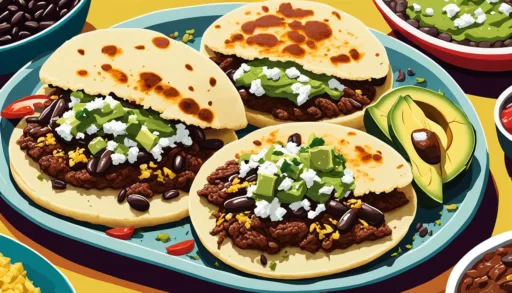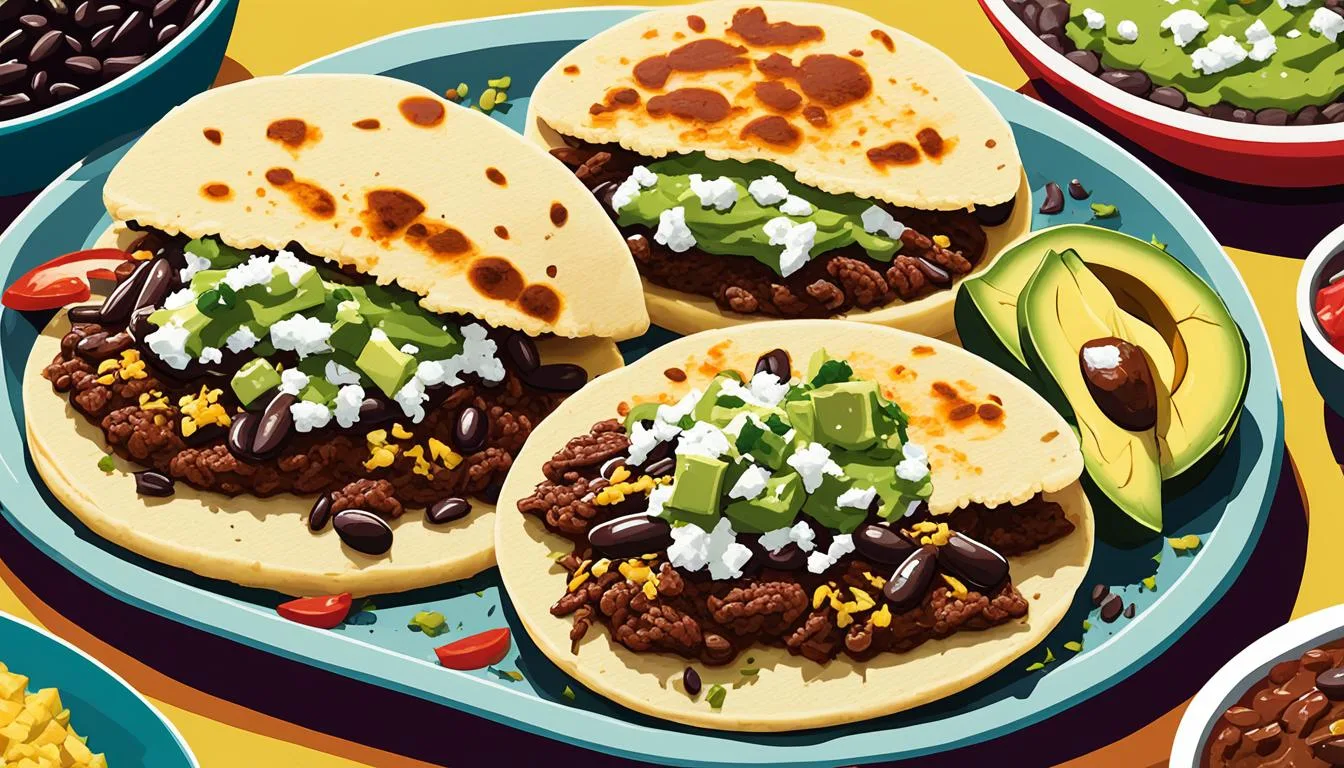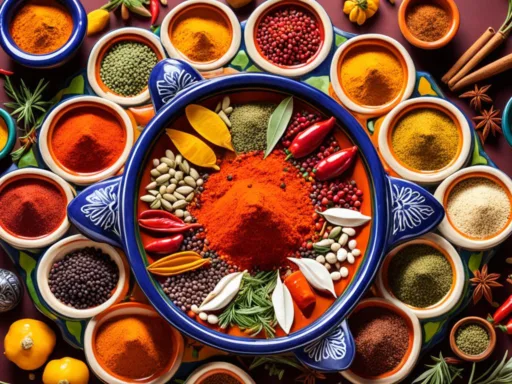Often shadowed by its more renowned Latin American cousins, Venezuelan cuisine remains one of the continent’s best-kept culinary secrets. But what makes it so uniquely tantalizing to the palate of gastronomes and food lovers alike? With a rich heritage that is as varied as its landscapes, Venezuelan Cuisine Discoveries offer an amalgam of tastes that begs to be explored. From the sun-kissed Caribbean coasts to the Andean peaks, explore Venezuelan gastronomy and encounter the authentic Venezuelan food that tells a story of history, heart, and heat.
Indulging in this culinary voyage, one finds that Venezuela’s kitchen is not just an assortment of dishes; it’s a vibrant confluence of indigenous, African, and European influences that have simmered together over centuries. Staple ingredients like cornmeal, plantain, and hand cheese are the unsung heroes behind iconic treats such as arepas and pabellón criollo. So, let your senses embark on an expedition through the rich tapestry of flavors and aromas that is Venezuelan gastronomy—a journey that is bound to transform any skeptic into a passionate connoisseur.
Key Takeaways
- Uncover the multi-layered history of Venezuelan culinary traditions.
- Discover the authentic Venezuelan food that goes beyond the famous arepas.
- Learn about the diverse regional dishes that shape Venezuelan gastronomy.
- Explore the fundamental ingredients that form the backbone of Venezuelan flavors.
- Understand how cooking methods and communal heritage play a role in Venezuelan dishes.
The Tapestry of Venezuelan Cuisine: A Historic Fusion
The captivating history of traditional Venezuelan dishes is a chronicle of cultures melding together. Venezuelan culinary traditions reflect a blend of the rich flavors and ingredients from three continents, making it a unique culinary destination. This fusion is not just about flavor but also the Venezian cooking techniques that have been refined over centuries, telling the story of a nation’s journey through food.
Indigenous Roots and Spanish Influence
Long before the Spanish set foot on Venezuelan soil, the Arawaks, Caribs, and other indigenous tribes were cultivating a rich array of native crops. Corn, cassava, yams, and chili peppers formed the cornerstone of their diet. With the arrival of the Spanish came wheat, sugar cane, and livestock, which when combined with indigenous ingredients, forged the basis for many traditional Venezuelan dishes we see today.
African Traditions in Venezuelan Cooking
The African influence on Venezuelan cuisine cannot be understated. Brought over during the colonial slave trade, Africans introduced a variety of cooking techniques and flavors, including plantain and coco. Their culinary impact added depth and complexity, making Venezuelan gastronomy more robust and vibrant.
Modern Incorporations and International Flavors
In the 20th century, the oil boom opened Venezuela’s doors to new cultural influxes, modern practices, and international tastes. This period allowed for an infusion of global culinary influences, which, when integrated with the already diverse Venezuelan kitchen, further expanded the nation’s rich gastronomic repertoire.
| Ingredient | Origin | Cultural Impact |
|---|---|---|
| Corn | Indigenous | Base for arepas and cachapas |
| Cassava | Indigenous | Staple in diverse dishes |
| Plantain | African | Integral in sides and mains |
| Wheat | Spanish | Introduced breads and pastries |
| Sugar Cane | Spanish | Essential in desserts |
| Beef | Spanish | Core component of Pabellón Criollo |
In essence, the traditional Venezuelan dishes today are a testament to the nation’s ability to adapt and embrace the diversity of its people through the universal language of food. Take any Venezuelan culinary tradition, and beneath its surface, you will find a story of convergence and harmony, a culinary tapestry woven with threads from across the globe.
Ingredients at the Heart of Venezuelan Gastronomy
Delving into Venezuelan culinary delights means embracing a palette of flavors anchored by unique and traditional ingredients. Essential to understanding and preparing these dishes is a knowledge of the gastronomic staples that form the backbone of Venezuelan cuisine. When you explore Venezuelan gastronomy, you uncover a rich diversity of ingredients that are indispensable in crafting the country’s signature dishes.
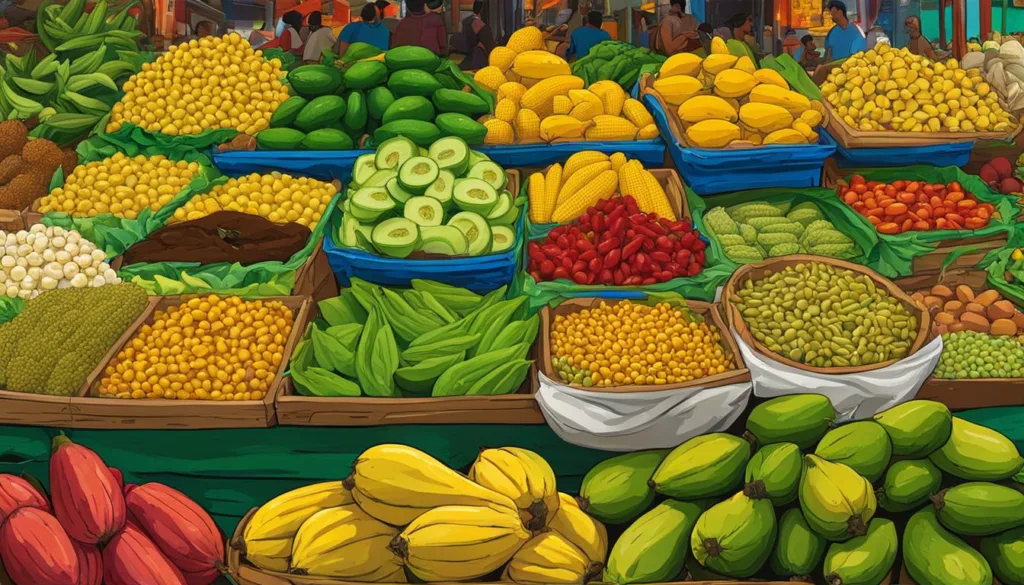
Corn flour, for instance, is not just a flour; it’s a canvas for the creation of the iconic arepas and hallacas, embodying the versatility and simplicity of Venezuelan fare. The earthy yuca is transformed into a hearty sancocho, while plantains are sliced and fried into crispy tostones, each underlining the cuisine’s reliance on home-grown produce.
- Corn Flour – for arepas and hallacas
- Yuca – central in dishes like sancocho
- Plantains – versatile, served as tostones or sweetly ripe
- Sweet Chili – contributing to the sweet flavor profiles
- Protein Varieties – including beef, chicken, pork, and hand cheese
A table of Venezuelan flavors would be incomplete without mentioning the role of proteins such as beef, chicken, pork, and the unmatched hand cheese, each adding a layer of depth and richness that is characteristic of the vibrant local fare. Pairing these with the sweetness of native chili peppers, the composition of Venezuelan cuisine further exemplifies a perfect harmony of flavors.
| Ingredient | Role in Venezuelan Gastronomy | Typical Dishes |
|---|---|---|
| Corn Flour | Foundation for staple dishes | Arepas, Hallacas |
| Yuca | Hearty root vegetable | Sancocho, Boiled Yuca with Mojo Sauce |
| Plantains | Sweet and savory variations | Tostones, Tajadas |
| Sweet Chili | Flavor enhancer | Guasacaca, Sweet Chili Salsa |
| Proteins | Essential for completeness | Pabellón Criollo, Asado Negro |
Integral to the preparation of these dishes are the customary tools and utensils. The budare, a griddle central to cooking perfectly crisp arepas, the hand mill used to grind fresh corn, and the timeless mortar and pestle, crucial for creating the pastes and sauces that accompany many dishes, represent the hands-on approach to Venezuelan cooking.
Authentic Venezuelan Food: More Than Arepas and Pabellón Criollo
The culinary landscape of Venezuelan cuisine extends well beyond the universally known arepas and the rich flavors of pabellón criollo. Venezuelan culinary traditions run deep, with an array of traditional Venezuelan dishes that are quintessential to any festive celebration and everyday life. Each authentic Venezuelan food item is a story, a tradition, an occasion in itself. Let’s venture into some less ubiquitous but equally tantalizing dishes that grace the Venezuelan table.
The Humble Hallaca: A Holiday Essential
Hallacas are the centerpiece in a Venezuelan Christmas. This is when families unite in a culinary ritual of preparing these tamale-like bundles. The meticulous creation involves corn dough, filled with a slow-cooked stew of meats and adorned with raisins, olives, and capers, finally wrapped in banana leaves. Each step is steeped in Venezuelan culinary traditions, turning cooking into a communal art form cherished across the nation.
Cachapas: A Sweet Corn Sensation
Cachapas are a testament to the sweet perspective of Venezuelan gastronomy. This rustic, griddle-cooked cake made from tender corn batter becomes a palette for flavors such as creamy ‘queso de mano’ or tangy ‘queso guayanés’. Often enjoyed roadside, these corn cakes are as much a comfort food staple as they are a celebratory treat, marking them a versatile delight in the trove of authentic Venezuelan food.
Coastal Delicacies: Fresh From the Sea
Venezuelan coastal towns boast a bounty of sea treasures, transforming local availability into exquisite dishes like Cazuela de Mariscos. This seafood stew, punctuated with the freshest catch of the day and simmered in a tomato-based broth, exemplifies how geographic diversity influences the palate of traditional Venezuelan dishes. Such coastal delicacies reflect a harmonious blend of local produce and ancestral culinary practices.
Venezuelan Culinary Delights: Tasting the Regional Differences
When you explore Venezuelan gastronomy, you unearth a treasure trove of flavors that are as varied as the nation’s topography. The local traditional Venezuelan dishes reflect a storied heritage deeply rooted in the land and its bounty.
Let’s begin our journey along the azure Caribbean coast, where the catch of the day dictates the menu. Here, the essence of the ocean is captured within every bite of crispy fried red snapper, skillfully prepared using age-old Venezuelan cooking techniques. Venture inland, and the scene shifts to the vast plains of Los Llanos. In this cowboy country, beef reigns supreme with hearty dishes such as Carne en vara, a testament to the region’s vast cattle ranching culture.
As we ascend to the cool, verdant Andean highlands, dairy products take center stage. Local cheeses and milk sweets mirror the area’s cooler climate and fertile lands, a true ode to the highlands’ pastoral landscapes. Each of these regional specialties encapsulates not just a palate-pleasing experience but also the adaptive spirit of Venezuelan culinary traditions.
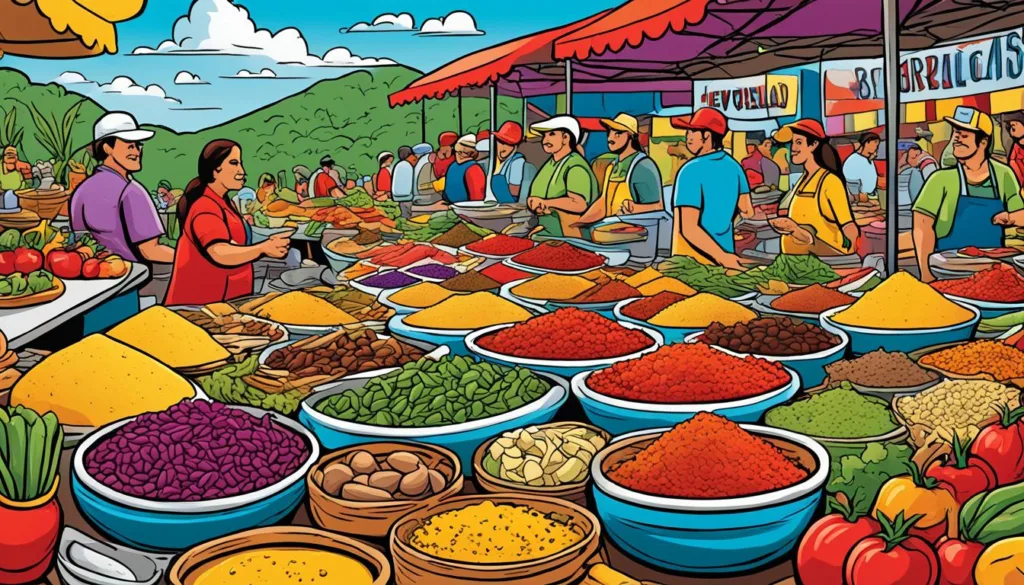
Below is a glimpse of how regional diversity influences the gastronomic fabric of Venezuela:
| Region | Featured Ingredient | Signature Dish | Preparation Technique |
|---|---|---|---|
| Caribbean Coast | Seafood | Fried Red Snapper | Frying |
| Los Llanos | Beef | Carne en vara | Grilling on a spit |
| Andean Highlands | Dairy Products | Local Cheeses / Milk Sweets | Aging/Curdling |
Through these dishes, it’s clear that each region beautifully articulates its own story, riding on the back of longstanding ancestral traditions and locally-sourced components. By engaging with these dishes, we don’t just explore Venezuelan gastronomy; we become a part of it, even if just as momentary guests at the table of this country’s rich culinary narrative.
From Casual Street Food to Gourmet: The Popular Venezuelan Recipes
Exploring the popular Venezuelan recipes is an adventure into a world where every bite encapsulates a story of cultural confluence and tradition. Venezuelan cuisine discoveries offer a broad palette ranging from the simplest street food favorites to the most intricate gourmet dishes. Among the culinary treasures, one can find the irresistibly cheesy Tequeños, a go-to snack enjoyed across the country, and the comprehensive pabellón criollo, a platter that brings together the very essence of Venezuelan heritage and flavors.
Among the canvases of flavors, the arepa reigns supreme, renowned for its adaptability and popularity, it’s a canvas for a variety of fillings, from the traditional carne mechada to the inventive plantain and black bean combinations. An undeniable sweet counterpart to the savory arepa is the cachapa, a tender sweet corn pancake often graced with a slice of creamy hand cheese, encapsulating the sweet corn appeal that dominates in the hearts of locals and gastronomes alike.
Making the visit to Venezuela or experiencing its cuisine abroad is to embrace the contrasts and traditions, from a simple handful of fried plantains to the complexity of a well-crafted Asado Negro. The flavors are an ode to the country’s rich environmental offerings, coupled with the culinary history that has simmered over centuries. Venezuelan food is not merely about sustenance but about communal tradition and the shared joy of a meal prepared with memories and anticipation.
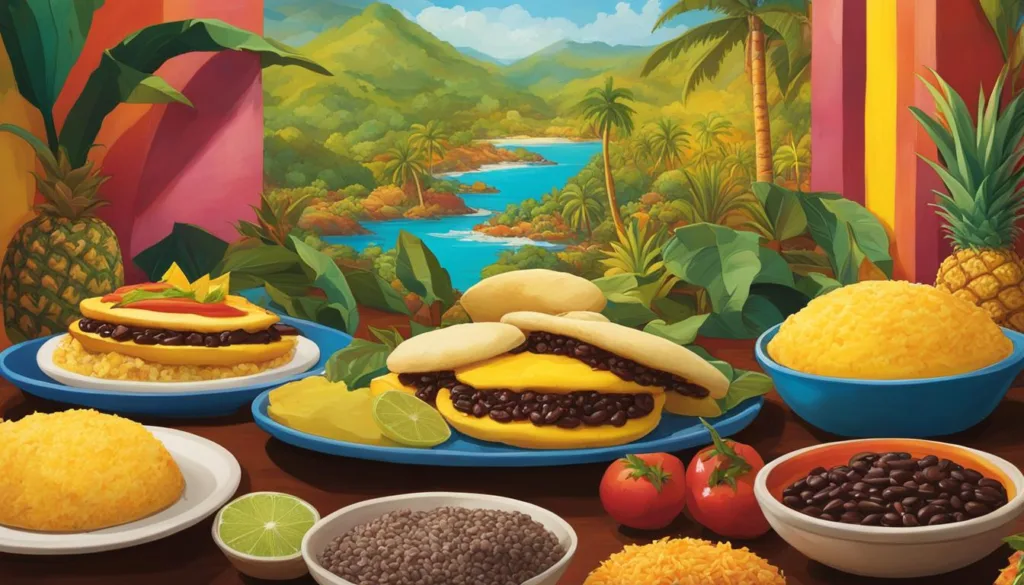
With every dish that hails from this vibrant cuisine, one engages with a piece of history, a dollop of culture, and a generous sprinkling of communal identity. The process of discovery through Venezuelan cuisine is a testament to the nation’s environmental bounty interwoven with the rich tapestry of its developmental history—a journey worth taking for any culinary enthusiast and culture explorer.
The Art of Preparation: Venezuelan Cooking Techniques Explored
Venezuelan culinary traditions are a testament to a vibrant culture that takes great pride in its cooking techniques. Delving deep into this gastronomic realm, we find that traditional Venezuelan dishes are not just meals; they are stories told through the customs of their creation. Each fold in an arepa, each stir in a pot of pabellón criollo, is a deliberate action steeped in history and shared experiences. Let’s take a closer look at the skills that have been passed down through generations and continue to define Venezuelan cuisine.
- Arepas: The cornerstone of every Venezuelan table, the art of making arepas involves mixing pre-cooked cornmeal with water and salt to form a dough, which is then shaped into rounds and cooked on a budare – a thick, round griddle that imparts a distinctive texture.
- Hallacas: Perhaps the most iconic of Venezuelan cooking techniques, assembling hallacas is a festive family affair. A carefully crafted corn dough is filled with a rich mix of meats, olives, raisins, and capers, then lovingly wrapped in banana leaves before being boiled to perfection.
- Tequeños: The art of wrapping these cheese sticks with a strip of dough is an exercise in patience and dexterity, ensuring each one is perfectly sealed to prevent cheese from escaping during frying.
Not only do these processes embody the heart of Venezuelan culinary traditions, but they also give life to the flavors that have defined a nation’s palate. It is the blend of technique and soul that makes Venezuelan dishes undeniably unique and cherished.
| Dish | Technique | Significance |
|---|---|---|
| Arepas | Griddling on a budare | A daily staple, symbolizing home and comfort |
| Hallacas | Wrapping with banana leaves and boiling | A festive, celebratory dish bringing families together |
| Tequeños | Filling and wrapping dough, deep-frying | A party favorite, indicative of Venezuela’s love for finger foods |
The meticulous nature of Venezuelan cooking techniques speaks volumes about the dedication to preserving culinary heritage. Every step, from prep to plate, reflects a lineage of flavor artisans who treat food as an art form, ensuring that each traditional Venezuelan dish is a true feast for the senses.
Explore Venezuelan Gastronomy: Diving Into Traditional Venezuelan Dishes
When it comes to indulging in the richness of South American cuisine, those who explore Venezuelan gastronomy are in for a true culinary treat. Venezuelan dishes encompass a diverse palette of flavors, each with its unique tale and role to play in the nation’s cultural melting pot.
Cultural Significance of Tequeños
Tequeños, a culinary delight hailing from Venezuelan soirees, have stood the test of time. From their aristocratic roots to becoming a staple at modern gatherings, these cheese-filled pastries symbolize the festive spirit of Venezuela. Now a celebrated finger food, Tequeños represent the blend of tradition and modernity in Venezuelan social life.
Traditional Patacones: A Staple at Every Table
The ingenuity of Venezuelan street food shines through in the making of Patacones. These double-fried plantain treats are beloved both as a humble snack and a versatile companion to a variety of dishes. Patacones encapsulate the simple yet robust nature of Venezuelan culinary delights, embodying both the resourcefulness and the rich flavor profile that the cuisine is known for.
Bollo Pelón and the Blend of Flavors
In every Bollo Pelón, there is a symphony of sensations waiting to be unraveled. This hearty dish, featuring a melange of savory meat housed within a tender cornmeal shell, is a prime example of the dynamic traditional Venezuelan dishes. Its multifaceted flavors mirror the country’s complex cultural landscape, where every meal is a homage to its diverse roots.
Venezuelan Cuisine Discoveries: A Journey Through Taste and Tradition
As the world craves new flavors and dining experiences, Venezuelan Cuisine Discoveries have captured the hearts of culinary adventurers. This vibrant gastronomy is an amalgamation of taste influenced by centuries of tradition and culture. From the rich, savory taste of the pabellón criollo to the sweet indulgence of cachapas, the breadth of popular Venezuelan recipes is astonishing.
The uniqueness of each dish is not just in its flavor but also in its history and the role it plays in the daily life of Venezuelans. The food is a reflection of a generous and varied land that has given rise to a wide array of ingredients and techniques, leading to iconic Venezuelan culinary delights that are enjoyed worldwide.
“To cook is to engage in a complex process of cultural exchange and understanding… Venezuelan cuisine is a beautiful symphony of such exchanges, echoing taste and tradition harmoniously on a plate.”
Discovering Venezuelan cuisine is notably about uncovering the subtle nuances that differentiate one regional specialty from another. Here’s a look at some of the dishes that have emerged as kitchen ambassadors of Venezuelan gastronomy, representing different regions and traditions in the country.
| Regional Specialty | Description | Ingredients |
|---|---|---|
| Patacon Zuliano | Fried green plantain sandwich with shredded beef, cheese, and various toppings | Green plantain, shredded beef, cheese, lettuce, tomatoes, mayonnaise |
| Arepas | Cornmeal patties stuffed with a variety of fillings | Cornmeal, water, salt, fillings like cheese, beans, or meat |
| Pabellón Criollo | Venezuela’s national dish with shredded beef, black beans, white rice, and fried plantains | Beef, black beans, rice, plantains |
| Cachapas | Sweet corn pancakes often served with queso de mano (soft cheese) | Corn, milk, cheese |
Beyond the realm of savory sensations, Venezuelan Cuisine Discoveries highlight the significance of shared meals. In every bite, there is the warmth of a family gathering, the joy of a festive celebration, and the pride of rich culinary traditions. Whether dining at a bustling street corner or a quiet family kitchen, the spirit of Venezuelan cuisine provides not just nourishment, but a connection to the roots of this colorful culture.
Conclusion
The voyage through Venezuelan culinary traditions has been nothing short of a symphony of tastes, where each dish plays its own distinct note yet contributes harmoniously to the overall melody. We have savored the ingredients and recipes, each with its own story, weaving a narrative that doubles as a historical journey through the nation’s multifaceted culture. The resultant blend, marked by the harmonious merging of indigenous, African, and European influences, progresses with modern, international touches while maintaining the essence that is quintessentially Venezuelan.
In the shared rituals of preparation and consumption of local fare, there lies a celebration of communal identity and cultural pride, extending beyond the plate to touch the soul of Venezuela. From the comfort offered by traditional staples such as arepas and hallacas, to the joy found in the crispy bite of a tequeño, the common threads of legacy and innovation are discernible. For gourmands and travelers alike, the exploration of Venezuelan Cuisine Discoveries promises a deeper understanding and a unique connection to a land whose spirit is encapsulated in its gastronomy.
Indeed, to delve into Venezuelan food is to experience a rich tapestry of savory excellence, a chorus of flavors that beckons the curious and rewards the adventurous. Each bite not only satisfies the palate but also brings one closer to grasping the vibrant culture and storied history of this diverse country. Such a journey is transformative, affording us a glimpse into the heart of Venezuela, where cuisine is the gateway to its vivacious way of life.
